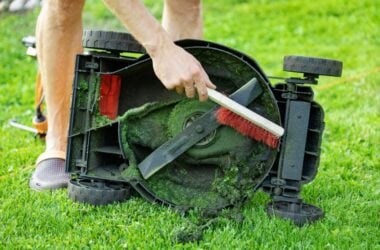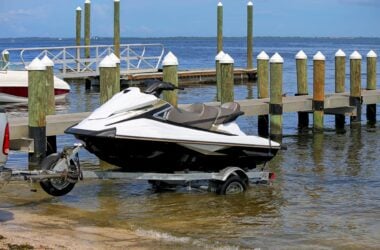Winter brings longer nights, colder temperatures, and cozy indoor days. For motorcycle enthusiasts, this time of year also marks the end of the riding season.
Motorcycles must be properly winterized and stored while they’re not in use. Whether you’re a new motorcycle owner, or you’re simply brushing up on the usual procedure, here’s why you need to winterize your motorcycle and 12 easy ways to do it.
Why Is Winterizing Your Motorcycle Important?
Just as you wouldn’t leave your bicycle stashed outside for weeks on end during the winter, the same rule should apply to your motorcycle. As a best practice, you should never leave your motorcycle parked in cold weather for extended periods of time. Freezing temperatures can cause components to contract, resulting in cracked hoses/seals or even a dead battery.
Exposure to snow, ice, and road salt can also accelerate corrosion and rust, while moisture buildup in various parts can lead to electrical issues. The cold weather also thickens the engine oil, making it less effective at lubricating engine components.
Some riders, especially those in warmer climates, continue to use their bikes in the winter, but if you don’t plan on using your motorcycle for a long period of time, you’ll need to properly winterize it.
Here are 12 easy steps to winterizing your motorcycle.
12 Steps To Winterize Your Motorcycle
Step #1: Take Your Motorcycle for a Ride
Taking your motorcycle for a final spin before stashing it away for the winter will help keep the engine warm and the bike lubricated. This also helps you get a feel for how your bike rides and any repairs it might need.
While on your ride, pay attention to any usual sounds coming from the engine or any jumpiness in the suspension. These could be a sign you want to take your bike in for repairs before you store it for the winter.
Step #2: Fuel Up
Fill the gas tank completely to prevent moisture accumulation. If water gets in your tank, it could lead to rust and corrosion, or if you store your motorcycle outside, cracked engine parts due to water expansion.
Step #3: Use Fuel Stabilizer
Next, invest in some fuel stabilizer or fuel treatment. This substance prolongs the shelf life of gasoline, which degrades over time due to the presence of ethanol. Treating the fuel in your motorcycle prevents it from degrading and makes it easier to start up your engine again after a dormant period.
When you add a stabilizer to your fuel tank, make sure you follow the manufacturer’s recommended dosage, which is typically based on the fuel tank’s capacity. After adding the stabilizer, run the engine for a few minutes to ensure the treated fuel circulates through the entire fuel system.
Step #4: Lube the Bike
Next, clean the motorcycle chain and any other pivot points, and then apply a quality lubricant. This maintenance step helps prevent rust and corrosion during the storage period. A well-lubricated chain reduces the risk of stiffening, which can cause transmission issues.
Step #5: Change the Oil and Filter
You should probably change your bike’s oil once every six months, but it’s especially important to do it right before you store your motorcycle for the winter. This process removes dirty oil and ensures that the engine is protected with fresh oil.
Begin by removing the oil filler cap or dipstick to check your oil levels. Also, check for milkiness or excessive metal flakes in the oil. If either occurs, notify your mechanic.
Next, place a drain pan under the drain plug beneath the bike and begin to unscrew the drain plug screw (make sure it is in fact the drain plug screw). Let the bike empty of all the oil until no oil is trickling out. For bikes with internal filters, locate the oil filter and unscrew the access plate. For external filters, simply unscrew the filter.
At this point, replace the sealing O-ring on the drain plug screw. Once you have cleaned the sealing surface of excess oil or any left-over O-rings, screw the new filter on. Replace the drain plug screw and fill the bike with oil.
Step #6: Replace The Fluids
You’ll also want to check and replace other essential fluids such as brake fluid and coolant. These fluids play vital roles in your motorcycle’s performance and longevity.
Brake fluid should be checked for discoloration or contamination, as these signs indicate a need for replacement. Similarly, coolant levels and conditions must be assessed to ensure efficient engine cooling and prevent overheating.
Step #7: Wash and Wax Your Bike
By thoroughly washing and waxing your bike, you not only remove dirt and salt but also prevent corrosion. To start, gently spray and wash your motorcycle with a car wash soap or motorcycle-specific cleaner.
Avoid getting water inside the motorcycle’s exhaust or the air cleaner housing.
Add a coat of wax to protect against moisture, and spray all metal surfaces with a light coat of WD-40, a multi-purpose penetrating oil and water-displacing spray.
Step #8: Tire Prep
You’ll also want to pay attention to your tires. Start by inspecting tires for any signs of wear, damage, or punctures. It’s better to deal with any issues before leaving your bike unattended for the season, as any existing issues, such as punctures, can worsen when left untreated for several months.
Make sure your tires are inflated to the recommended pressure based on the make and model of your motorcycle. This is typically between 28 to 36 PSI (pounds per square inch). To protect them from the cold, park your motorcycle on some cardboard, which acts as insulation.
You can also suspend your tires (or just your back tire) in order to prevent any flat spots. If you don’t have the gear to suspend the tires, just roll your tires every few weeks.
Step #9: Fog the Engine
If you anticipate not using your motorcycle for more than 6 months, you may want to fog the engine. Fogging oil is a specialized oil designed to protect the internal components of an engine during prolonged periods of inactivity. It creates a thin protective coating on the internal surfaces, preventing corrosion and rust caused by moisture buildup.
To apply fogging oil, unscrew the spark plug and spray some engine fog into the cylinders. Reinstall the spark plugs and turn the engine over a few more times to evenly distribute the oil.
Step #10: Cover your Motorcycle
To keep your motorcycle from collecting dust, place a sturdy cover on top and plug your exhaust. This will also stop rodents from getting into your vehicle. You can find covers available on Amazon or motorsport companies like Revzilla and Nelson Rigg.
Step #11: Disconnect the Battery
It’s good practice to disconnect the battery if you aren’t using your motorcycle for an extended period of time. Begin by locating the battery (located beneath the seat in most modern bikes) and making sure it is at full charge. Disconnect the negative wire first, followed by the positive wire. Then, slowly pull out the battery.
You’ll want to store the battery in a cool place with no moisture. Consider using a trickle charger or a battery tender to help the battery retain its charge and prolong its lifespan.
Step #12: Find Storage
Of course, where you store your motorcycle is just as important as how you store it. Find a storage area that shields your bike from the elements, such as direct sunlight, rain, snow, and extreme temperatures. Ideally, opt for a garage, shed, or extra room in your house.
Ensure the chosen location is easily accessible for periodic checks and maintenance tasks during the storage period. If you don’t have any space in your home, consider renting a storage unit or renting space from a peer-to-peer storage facility like Neighbor.
When Spring Hits
With these tips, your motorcycle will be in top condition when spring rolls in. Before riding your motorcycle post-storage, you’ll need to de-winterize. To do so, conduct a thorough inspection–checking tire pressure, ensuring all fluids are at the recommended levels, and testing the battery and lights. If everything looks good, you’re ready to hit the road!







